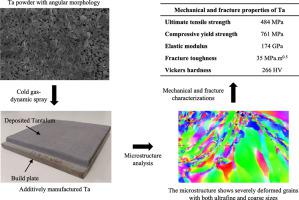Additive Manufacturing ( IF 11.0 ) Pub Date : 2021-09-10 , DOI: 10.1016/j.addma.2021.102243 Davoud M. Jafarlou 1 , Bryer C. Sousa 2 , Matthew A. Gleason 2 , Gehn Ferguson 3 , Aaron T. Nardi 3 , Danielle L. Cote 2 , Ian R. Grosse 1

|
Additive manufacturing (AM) of refractory metals, including tantalum (Ta), is highly valued due to the wide application of these materials in different industrial sectors where outstanding mechanical properties at elevated temperatures are required. Among metal AM processes, newly introduced cold gas-dynamic spray or, more commonly, cold spray (CS) offers a unique opportunity for solid-state consolidation of refractory metals. This research presents the CS process as a method for additive manufacturing of Ta. Following the successful manufacturing of free-standing Ta, an extensive mechanical characterization at the macro and nano levels has been carried out to evaluate the material's structural integrity. Anisotropy in the mechanical properties, which is one of the major concerns in the AM-produced materials, was extensively analyzed at both the macro and nano levels. The produced Ta's resistance against the pre-existing crack was studied by evaluating the far-field J-integral versus the crack extension (J-R curve). The influence of microstructural characteristics and process-induced defects such as pores and micro-cracks on the Ta's mechanical and fracture properties was studied to explain the performance-microstructure linkage. The macro and nanomechanical testing results indicated an elastic modulus and ultimate tensile strength in the range of vacuum-arc melted or electron-beam melted Ta ingots following cold-working. The microstructure analysis demonstrated a mixture of ultrafine grains and highly elongated coarse grains, explaining the CS-produced Ta high strength. Moreover, excellent isotropy in the mechanical properties was observed at both the macro and nano levels. This finding distinguishes the CS process from the laser-based AM process in which mechanical properties highly depend on the build direction. On the other hand, the CS-produced Ta exhibited brittle characteristics during uniaxial tensile loading and ductile behavior during the uniaxial compression test. Also, stable crack growth accompanied by crack branching was observed in the CS-produced Ta. The crack branching and formation of secondary cracks have been identified as the mechanisms retard crack extension. Overall, this research revealed that the CS process is a promising AM technique for producing tantalum-based components.
中文翻译:

使用高压冷气动力喷涂固态增材制造钽
包括钽 (Ta) 在内的难熔金属的增材制造 (AM) 受到高度重视,因为这些材料广泛应用于需要在高温下具有出色机械性能的不同工业部门。在金属增材制造工艺中,新引入的冷气动力喷涂或更常见的冷喷涂 (CS) 为难熔金属的固态固结提供了独特的机会。本研究将 CS 工艺作为一种增材制造 Ta 的方法。在成功制造独立的 Ta 之后,在宏观和纳米水平上进行了广泛的机械表征,以评估材料的结构完整性。机械性能的各向异性,这是 AM 生产的材料中的主要问题之一,在宏观和纳米两个层面进行了广泛的分析。通过评估远场,研究了生成的 Ta 对预先存在的裂纹的抵抗力J -积分与裂纹扩展 ( JR曲线)。研究了微观结构特征和工艺引起的缺陷(例如孔隙和微裂纹)对 Ta 的机械和断裂性能的影响,以解释性能与微观结构的联系。宏观和纳米力学测试结果表明,冷加工后真空电弧熔化或电子束熔化的钽锭具有弹性模量和极限拉伸强度。微观结构分析表明超细晶粒和高度拉长的粗晶粒的混合物,解释了 CS 生产的 Ta 的高强度。此外,在宏观和纳米水平上都观察到了优异的机械性能各向同性。这一发现将 CS 工艺与基于激光的 AM 工艺区分开来,后者的机械性能高度依赖于构建方向。另一方面,CS 生产的 Ta 在单轴拉伸加载过程中表现出脆性特征,在单轴压缩试验中表现出延展性。此外,在 CS 生产的 Ta 中观察到伴随裂纹分支的稳定裂纹扩展。裂纹分支和二次裂纹的形成已被确定为延缓裂纹扩展的机制。总体而言,这项研究表明 CS 工艺是一种很有前途的 AM 技术,用于生产基于钽的组件。


























 京公网安备 11010802027423号
京公网安备 11010802027423号